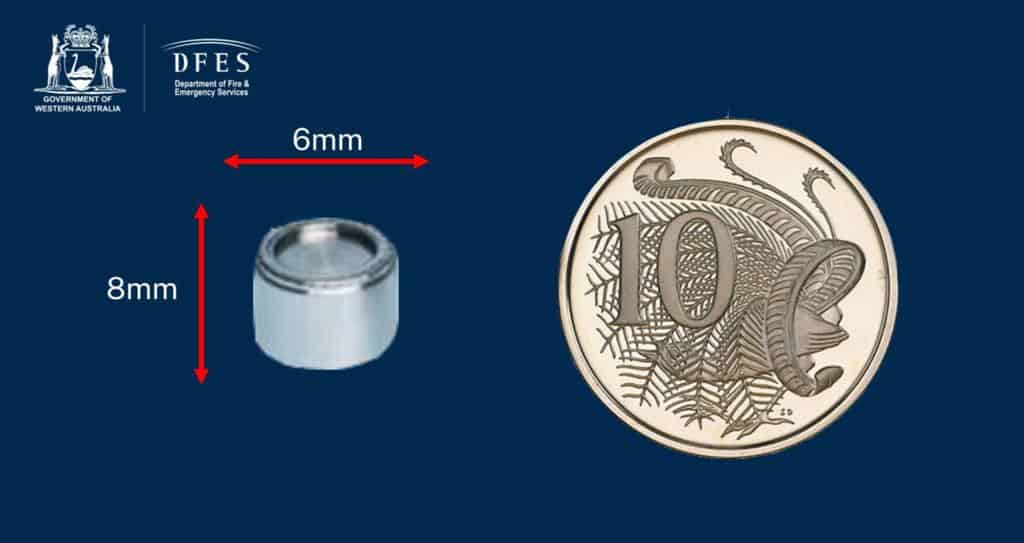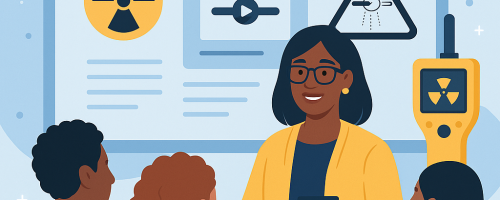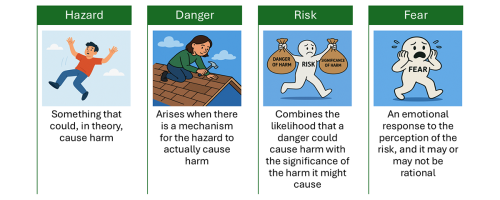Radioactive capsule image courtesy of DFES Australia
Modern workplaces must comply with many Health and Safety standards. If you have experienced a common workplace incident such as a slip, trip, or fall, you immediately feel it and can take action. Because radiation is the kind of hazard that cannot be detected by our senses, it may be tempting to put it on the back burner, as the consequence of excessive exposure are seldom immediate. The events in Australia, making news globally, involving the loss of a radioactive capsule remind us exactly why a sound Radiation Safety Program that includes a well-developed Transportation of Dangerous Goods component and an effective compliance protocol is key to the safety of workers, the public, and environment.
While this incident, described in the media release issued by their Department of Health on January 27, 2023, is occurring on a different continent, it has garnered international attention due to the extent of the area searched and the potential health hazards involved. It was small Cs-137 source missing from a nuclear gauge; but, this cylindrical capsule 8mm x 6mm in dimension initiated a search of 1400 km of roadway and a major public health warning. It has been successfully retrieved this morning, February 1, 2023.
Cs-137 is a radioactive isotope of cesium with a half-life of 30 years. When it decays it emits beta and gamma radiation. Beta radiation is made up of small particles, electrons or positrons, being emitted from the nucleus as a proton converts to a neutron or a neutron converts to a proton. It can travel about 0.2 cm in tissues, so it can penetrate the skin if exposed externally. Gamma radiation is electromagnetic and behaves like x-rays: it can travel through materials and body tissues, and its energy is absorbed more readily by denser materials. (For more information see our free course: Understanding Radiation.)
Because of its ability to emit gamma radiation, Cs-137 is widely used in devices called nuclear gauges. Nuclear gauges allow for imaging or analysis of materials without the need for an external power source, batteries, or large capacitors required by x-ray equipment. There are two types of nuclear gauges, fixed and portable. Fixed gauges are attached to objects like pipes or large tanks to provide information on flow rates, density, containment levels, etc. Portable gauges are used for tasks like determining the composition, density, or moisture levels of soil, asphalt, or other materials.
Nuclear gauges are used across Canada. Their use is regulated by the Canadian Nuclear Safety Commission (CNSC). A search of their licence database shows that there are currently 433 licences for portable gauges and 452 licences for fixed gauges. Each licence can have multiple gauges fall under it, so the number of individual gauges is higher. Fixed gauges would be shipped infrequently. Portable gauges are shipped often, as they are moved from job site to job site. News reports out of Australia are not clear on which type of gauge was being shipped and for what reason.
Here in Canada, the CNSC along with Transport Canada regulate the use and transportation of nuclear materials, adopting regulations published by the International Atomic Energy Agency (IAEA). This is a highly regulated field, guided by the basic philosophy that safety relies heavily on the design of the transport package. Organizations involved in the shipment of nuclear materials, including the transport company, must have a Radiation Protection Program. Individuals involved must have training in the Transportation of Dangerous Goods with specific training in Class 7, Radioactive Materials. They must also have training in the CNSC radiation protection and transport regulations, WHMIS, and the radiation safety program under their licence. TDG training must be renewed every 3 years.
The protocols and standards in place assume that there is always a risk of a transport accident during shipment. Regulations address the preparation of the shipment; the design, production, use, maintenance, and repair of packaging and packages; the preparation, consigning, handling, loading, carriage, and storage during transport; the receipt at the final destination; and the unloading of packages. Expectations are more and more stringent as risks to the health and safety of persons, national security, and the environment associated with the radioactive source increase.
For example, the IAEA Regulations outline requirements for package testing. These requirements consider various possible transport accident conditions, such as rough handling, impact, or contact with water. Packages must be able to be handled safely and easily and properly secured. As the danger of the source increases, so does the expectations for the package. For all but the lowest-risk shipments, packages must have certification documents. Packages for high-risk shipments must be registered and approved for use with the CNSC.
Serious incidents involving nuclear materials and public safety are rare. In 2021 in Canada there were no risk-significant transportation events registered with the CNSC. To put this into perspective, there are over a million of packages with radioactive material being transported in Canada on an annual basis.
Ultimately, it is up to workplaces to develop and implement safety programs that ensure compliance and provide protection to those involved in the transportation of all dangerous goods, including the protection of the public and the environment. We believe that education and training of workers is key to the successful implementation of such programs.
A good TDG course focused on nuclear materials will include information on the properties of radioactive materials; the regulations surrounding shipping of radioactive materials; and emergency preparedness and response. In addition to this training, workplaces must educate and assess those doing the work on internal policies and procedures. Proper training and assessment are necessary to ensure everyone is aware of and is following these safety practices.
With competing demands for priority, it may be tempting to put off health and safety training until there is more time or money. More so for radiation safety, because we have no senses to detect exposure. When things are going well, it is easy to become complacent. But complacency can lead to incidents. Incidents which have very large implications, as shown by what is happening in Australia. It is fundamental that organizations involved with nuclear materials, including their transportation, have a strong Radiation Protection Program which requires regular training and assessment. It is our sincere belief that for workplaces that use radioactive sources an active radiation safety component is key to building a strong overall safety culture.
As a national not-for-profit, we provide numerous free resources to workers and the public on the topic of radiation protection. The following free webinar recordings are relevant to this issue:
- June 9, 2022: Transportation of Nuclear Materials
- February 25, 2021: Health Effects of Exposure to Radiation
Please know that in addition to our training, consulting, and laboratory services, the Radiation Safety Institute of Canada is available to answer any questions about the risk and threat of radiation as part of our free of charge Information service in radiation safety. This service is open to all Canadians concerned about any radiation safety related issue. Please reach out any time by e-mail at info@radiationsafety.ca or call toll free at 1-800-263-5803.







